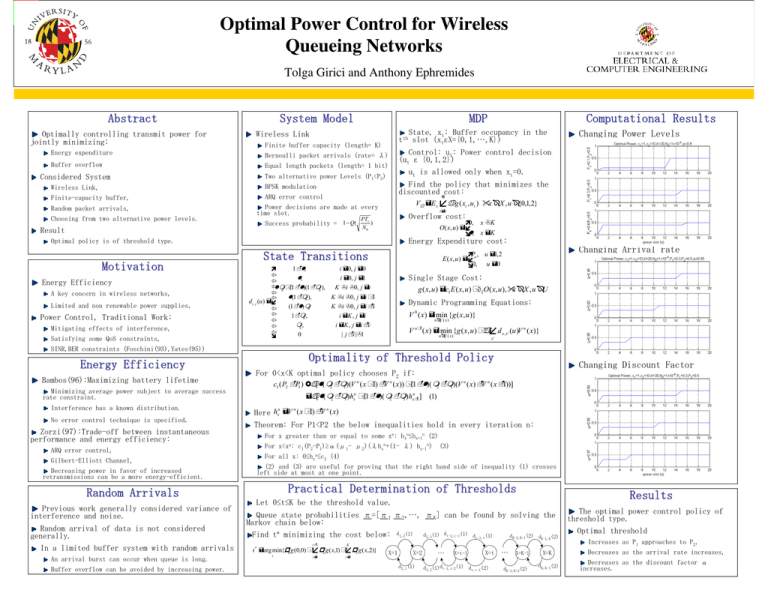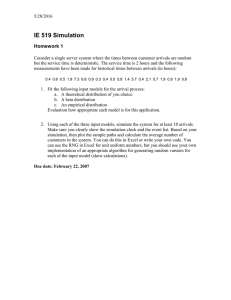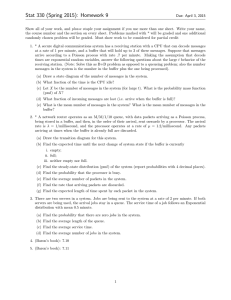Optimal Power Control for Wireless Queueing Networks Computational Results Abstract
advertisement

Optimal Power Control for Wireless
Queueing Networks
Tolga Girici and Anthony Ephremides
Abstract
Optimally controlling transmit power for
jointly minimizing:
System Model
Wireless Link
Finite buffer capacity (length= K)
Bernoulli packet arrivals (rate= λ)
Equal length packets (length= 1 bit)
Energy expenditure
Buffer overflow
Considered System
Wireless Link,
Finite-capacity buffer,
Random packet arrivals,
Choosing from two alternative power levels.
MDP
Two alternative power Levels (P1<P2)
BPSK modulation
ARQ error control
Power decisions are made at every
time slot.
PTs
)
Success probability = 1 − Q(
t 0
Overflow cost:
O ( x, u )
State Transitions
Energy Efficiency
A key concern in wireless networks,
Limited and non renewable power supplies.
d i , j (u )
Power Control, Traditional Work:
Mitigating effects of interference,
Satisfying some QoS constraints,
Bambos(96):Maximizing battery lifetime
No error control technique is specified.
Zorzi(97):Trade-off between instantaneous
performance and energy efficiency:
ARQ error control,
Gilbert-Elliott Channel,
Decreasing power in favor of increased
retransmissions can be a more energy-efficient.
Random Arrivals
Previous work generally considered variance of
interference and noise.
Random arrival of data is not considered
generally.
In a limited buffer system with random arrivals
An arrival burst can occur when queue is long.
Buffer overflow can be avoided by increasing power.
Changing Arrival rate
ÒPu , u 1,2
Ó
Ô0, u 0
Single Stage Cost:
g ( x, u ) c1 E ( x, u ) c2O ( x, u ), x ´X , u ´U
Dynamic Programming Equations:
V 0 ( x)
min {g ( x, u )}
u´U ( x )
V n 1 ( x)
min {g ( x, u ) HË d x , x ' (u )V n ( x)}
u´U ( x )
x'
Optimality of Threshold Policy
Changing Discount Factor
For 0<x<K optimal policy chooses P2 if:
c1 ( P2 P1 ) }H[z( 2 1 )(V n ( x 1) V n ( x)) (1 z)( 2 1 )(V n ( x) V n (x 1))]
Minimizing average power subject to average success
rate constraint.
Interference has a known distribution.
E ( x, u )
i 0, j 0
1 z,
Ò
Õ
z
i 0, j 1
,
Õ
Õz
K !i !0, j i
(1 z)(1 u ),
u Õ
z(1 u ),
K !i !0, j i 1
Õ
Ó
K !i !0, j i (1 z) u
1
Õ
Õ
i K, j i
1 u ,
Õ
u ,
i K, j i 1
Õ
Õ
0
| j i |!1
Ô
SINR,BER constraints (Foschini(93),Yates(95))
Energy Efficiency
Ò0, x !K
Ó
Ôz, x K
Energy Expenditure cost:
Optimal policy is of threshold type.
Motivation
Changing Power Levels
VH E x ËHt g ( xt , ut ) x ´X , u ´{0,1,2}
N0
Result
Computational Results
State, xt: Buffer occupancy in the
tth slot (xtєX={0,1,…,K})
Control: ut: Power control decision
(ut є {0,1,2})
ut is allowed only when xt=0.
Find the policy that minimizes the
discounted cost:
H[z( 2 1 )hxn (1 z)( 2 1 )hxn1 ] (1)
Here h V ( x 1) V ( x)
Theorem: For P1<P2 the below inequalities hold in every iteration n:
n
x
n
n
For x greater than or equal to some xn: hxn≤hx+1n (2)
For x<xn: c1(P2-P1)≥α(μ1- μ2)(λhxn+(1- λ) hx-1n) (3)
For all x: 0≤hxn≤c2 (4)
(2) and (3) are useful for proving that the right hand side of inequality (1) crosses
left side at most at one point.
Practical Determination of Thresholds
Let 0≤t≤K be the threshold value.
Queue state probabilities π=[π1 π2,…, πK] can be found by solving the
Markov chain below:
Find t* minimizing the cost below: d1,2(1) d2,3(1) dt-2,t-1(1) dt-1,t(1)
dK-2,K-1(2) dK-1,K(2)
t
1
t*
K
arg min{0t g (0,0) Ëxt g ( x,1) Ëxt g ( x,2)}
t
x 1
x t
X=1
X=2
d2,1(1)
…
X=t-1
X=t
d3,2(1)dt-1,t-2(1) dt,t-1(2)
…
X=K-1
dK-1,K-2(2)
X=K
dK,K-1(2)
Results
The optimal power control policy of
threshold type.
Optimal threshold
Increases as P1 approaches to P2,
Decreases as the arrival rate increases,
Decreases as the discount factor α
increases.





